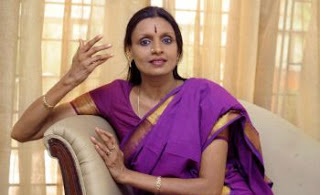
Priyadarsini Govind in conversation with Sukanya Sankar at the Dance India Asia Pacific 2013 in Singapore. Excerpts from the interview held in the first week of June—more than a month before her appointment as Director, Kalakshetra.
Sukanya Sankar: How would you describe your depiction of sringara abhinaya, vis-à-vis your contemporaries?
Priyadarsini Govind: Abhinaya is a kind of cathartic experience for all of us. We are dramatic by nature irrespective of caste, creed, race, culture, and religion, and we grow up with stories. Because of that, and because we are emotional we identify well with abhinaya. The knowledge or the awareness of abhinaya is really something that needs to be worked upon. Those of us who grew up in Chennai are more fortunate than others in this respect. My dance is highly influenced by my guru Kalanidhi Narayanan and her approach to abhinaya because I started learning at a very young age when you take in without really questioning anything and you just grow with it. Even before I realised what dance meant, or what nritta and abhinaya were, I grew up with abhinaya. Kalanidhi Mami has influenced all aspects of my dance and other things too. Abhinaya is highly individualistic, because it is not something that can be wholly taught, No two thoughts of the same person are alike, so I can never absolutely replicate a thought even a second later. Nor can I totally imitate another person. All of us therefore have our own ways of visualizing a piece.
In my age group, I tend to look at things less stylistically, perhaps more as an experience that comes naturally from within, rather than actually follow a stylized pattern.. That is probably why I also receive a lot of flak from time to time. Even if it is something that we learned from Mami, I cannot absolutely replicate the metaphors she uses or what she advocates. Even the items that I learnt from her are totally different when I perform them today. But isn’t that the way it should be? On the whole, I guess my approach is perhaps a little more free, easy and natural than that of my contemporaries.
You have come a long way since you started learning with Kalanidhi Mami and S.K. Rajaratnam Pillai. Has your dancing changed? Have you introduced anything new?
I am sure it has changed, it must change. Unfortunately, I cannot watch my videos, so I do not know the way it has changed. In my solo repertoire I like to include something new every year. It is not under pressure, but more for the pleasure of working on different ideas, or music that interests you. Of course, I still love to perform a varnam that I did two years ago, and could present it for 10 or 15 years more. I like to work on a few pieces every year and that is influenced by how I have evolved over the years. So, naturally, it is different.
How does it feel to know that young dancers are trying to copy you and your style of dressing?
Honestly I am surprised and a little shocked. I have never thought about it that way. I am more worried about why am I receiving all that flak! There is another side to it too. A lot of senior people call me with the best of intentions and give me suggestions. I have the greatest respect for them, but at the same time I have also great respect for my designer Lakshmi Srinath. The kind of costumes the devadasis used in olden times was very interesting. You cannot get more variety than that in the prints, the texture, and the kind of combinations and the colours they used. I don’t think we are doing anything new. If at all people copy, the credit must go to them.
There is this problem of attracting youngsters to attend programmes, lecdems and to read about the arts. Do you have any ideas about cultivating interest in rebellious teenagers?
Yes. Even in my house, my daughter loves dance and my son used to, but now he is in his twenties and seems to be veering away. They feel some of the pieces I perform are very boring! They are very honest about it and I’m sure most youngsters today feel that way because there is a certain aspect of classicism that does not reach out to them. But I believe the onus is on the artists, the parents and the family.
If we want to teach our children good habits, we make them do it, don’t we? If you want them to read, you make sure they spend time reading. It is actually a cultivated taste, it is not something that comes naturally to most. The bottomline is that the awareness and interest for the arts has to be created by the family and by the artists. If both work together, then definitely our children will benefit from it. If I take my child to a library at the age of 15 without having taught him how to read from the age of three, he will definitely not be interested in going to the library. Similarly, if I don’t teach him to appreciate our arts and culture, he may not be attracted to a SPIC MACAY programme in his school unless—he is an extraordinarily sensitive child. Very few children naturally take to it because popular music and popular dance is definitely more appealing. So, instead of thinking that we have to somehow find a way to attract them, I think it is essential we understand that they will not be immediately attracted, but that their interest must be cultivated.
Your views on the current dance scene in Chennai?
Young dancers are very intelligent and smart. They are very media-Internet and tech savvy. They are courageous; many are willing to take this up as a career, a profession. There is a lot of camaraderie among them. It is fantastic. But what worries me is the trend of instant judgement, not always well-informed and lacking depth. They need guidance from their gurus and mentors or their family. Another cause for worry is that nowadays in India there is a certain lack of respect towards elders and gurus. Tolerance must be inculcated in youngsters aspiring to be artists. Nobody is perfect. There is a very high sense of entitlement, especially in India, which is not very healthy.
To get programmes, up-and-coming artists have to approach, and often pay the organisers. Will that practice ever go away?
I don’t know whether it will go away in Chennai. In the rest of the country it is not so. If five artists decide they will not pay to perform, there are a hundred people willing to do so. This problem is not confined to dance, it happens in the music scene too – it wasn’t there ten years ago. I think there is a basic problem in the dance scene because the dancer pays the musicians. So the expense is greater. I guess this practice has its roots in the nattuvanar tradition when the guru was paid and he paid the musicians. As the sabha could not choose the musicians for the dancer, they paid the entire remuneration to the guru or to the artist as the case may be. As most of the dancers belonged to affluent families it was a pleasure for them to teach their children and the nattuvanars too needed to make a living, so the practice suited everybody. In fact, most dancers like Kalanidhi Mami and others danced for fundraisers.
Later, when children from different strata of society started learning dance, not everybody could afford programmes.
Do you think artists, or in your case dancers, could make good art administrators?
I think we would make fantastic administrators if we did not dance. If I am performing at the pace that I am today, I cannot really teach. If I teach, I should not be a regular professional performer. Similarly, if I want to be an administrator, then I should not do anything else. I should be true to what I am doing. You can always prove that you can do this and that, but whether you are doing justice to either of them is a moot point, and I couldn’t do it.



